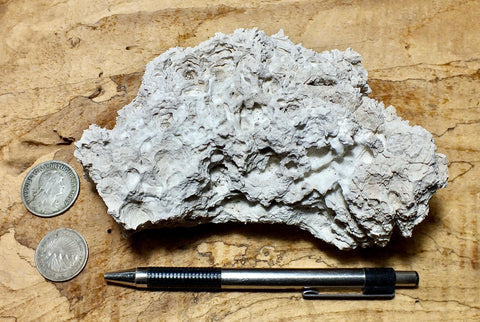caliche - caliche formed in uplifted Pleistocene lake beds, uncovered and partly dissolved by acidic rain - hand/display specimen
$ 9.50
Caliche underlies desert soils in a large part of the Western U.S. and in other arid areas. It is composed of calcium carbonate and can be tens of feet thick. An ideal caliche profile would have a hardpan at the surface progressing downward into a platy or laminar layer which overlies a nodular zone, and then intercepts the bedrock. Since a caliche takes tens to hundreds of thousands of years to form, changes in climate disrupt this sequence and an ideal profile is seldom seen.
The term caliche is Spanish from the Latin calx for lime. It forms when calcium carbonate is leached from the overlying soil and accumulates some distance below the surface. In parts of the Southwest, caliche posed a real challenge for pioneers when they attempted to dig wells.
This caliche formed in the Pleistocene lake beds of former Lake Tecopa in Inyo County, California. Sediment carried by glacial meltwater flowing from the Sierra Nevada at the end of the Ice Age was trapped in the basin of Lake Tecopa and was uncovered when the Amargosa River was unblocked and the lake drained. These sediments, mudstones and siltstones, are relatively soft. The caliche, near the surface, has been exposed by erosion as the area is dissected and is being dissolved by slightly acid rainwater, not a fast process where it seldom rains.
Select a specimen: When more than one specimen is shown, you can select a particular specimen by telling us what is in the photo with it, a black and silver pen, a black mechanical pencil or one of those plus some number of coins, or you can let us make the selection.
Making multiple purchases? Click on the "combine shipping" button in the shopping cart. We'll send an invoice with combined shipping. A link in that invoice will bring you back to checkout, no hassle.
Shipping: By Priority Mail or USPS Ground Advantage, whichever is cheaper. Click > here < for shipping rates. See comment at Note! Use back button to return to this page.






